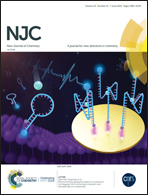Fractal pattern mediated superhydrophobic glass and metallic surfaces using PTFE particles: a generalized simple approach†
Abstract
Superhydrophobic surfaces are practically important for several real-life applications such as self-cleaning, anti-corrosion and drag reducing surfaces, non-wetting cloths, oil–water separation, water-repellent surfaces and microfluidic devices, etc. Herein, we report a simple and inexpensive dip coating technique for the formation of fractal patterns of polytetrafluoroethylene (PTFE) nanoparticles (NPs) on flat surfaces (glass and steel) and a stainless steel mesh, which in turn leads to a superhydrophobic surface after sintering at 250 °C. In this method, a mixture of sodium carboxymethyl cellulose (CMCNa) and oxalic acid was used as a template to organize the NPs into fractal patterns. In general, these patterns play a vital role in creating micro to nano-scale roughness, which is essential for the fabrication of superhydrophobic surfaces. These PTFE coated surfaces showed an average water contact angle of ∼152° for glass and flat stainless steel surfaces and 154° for the stainless steel mesh. These coated surfaces showed excellent self-cleaning properties. The fabricated superhydrophobic mesh also showed good efficiency for oil–water separation.



 Please wait while we load your content...
Please wait while we load your content...